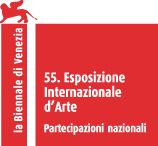h, painting
painting to the public (open-air)

year: 2012
form: collective acts
material: billboard
photo credit: Takashi Fujikawa
credits: created with Aoyama Meguro, Tokyo
artist’s notes:
A new context for producing a painting.
Both the acts of making and showing a painting can be performed "unplugged," ie, without an electric power source. Such actions can be performed under natural light, which means we can make a painting without relying on problematic nuclear power plants.
During the Meiji period, around the end of the 19th century, a group of Japanese artists influenced by famous Japanese painter Seiki Kuroda, who studied in Europe, formed what became known as the School of Open-Air Painting, or in Japanese "gai-koh-ha" ("school of natural light").
I slightly reinterpreted this name to mean "without using artificial light" - referring to paintings produced in open-air situations independent from any electric power supply - as a name with new meaning/context for painting now, that is, painting practice post the disaster of March 11 ("3.11") in Japan, and as a key phrase for addressing such painting-production and its political meaning, i.e., "airing" Japan's recent problems with radioactive contamination.
In 1964, Hiroshi Nakamura and Koichi Tateishi a.k.a. Kanko-Geijutsu-Kenkyujo (Research Center for Art Tourism) displayed huge paintings to the public in rush hour at Tokyo Station, in a project they dubbed "Walking Open Air Gallery." Here the name "Open-Air" and their action were a reference to the Meiji School of Open-Air Painting. And in my view, both actions in the open air can be connected to the present context of painting in post-3.11 Japan.
In this sense I propose an event that involves walking outside and showing a painting as a sort of protest. Let us counter the image of the artist/painter in Japan as not social or political by going out into the streets. Because now we know the political meaning of making a painting, or rather the painting itself.
アーティストノート:
絵を描くということが別の意味を帯び始めている。
絵を描く行為も、見せる行為も基本的に電力に頼らずに行えるアンプラグドな行為である。すべては自然光の中で行える。つまりそれは原子力発電に頼らずに作品が作れるということを意味する。
明治の頃、洋行帰りの絵描きを中心にして彼らに「外光派」という名前が付けられたことがあった。ぼくはそれを人工光を使わずに描く(人工光の外)と読み替えて(読み違えて)みたい。電気に頼らずに、開かれた外気、空間の中で絵を描くことを指す言葉として。震災以後の絵画制作を指す、別の言葉として。むしろ空気をオープンにしていく、そんな絵画制作を考えてみるための指標として。
1964年、中村宏と立石紘一による観光芸術研究所によって、二人の巨大な絵画がラッシュアワーの東京駅周辺を闊歩した。「路上歩行展」の英訳は「walking open air gallery」であり、「外光派」は「open-air painter」と書かれる。明治の「外光派」による「屋外制作」は64年の「路上歩行」へと言葉と行為を通して繋がり、そして震災以後の絵画制作が含み持つ現在の文脈へと接続する。
そして今回、ぼくたちは文字通りに絵を持って屋外を歩く。日本において、絵を描く行為はとかく社会とは無縁の無垢な芸術家像を生み出してきた。ここら辺でぼくらも街に繰り出すのもいいんじゃないだろうか。絵を描くことは、いや、絵画そのものがいまやポリティカルな意味合いを持ち始めているのだから。







